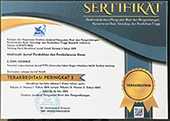Kemampuan Berpikir Kreatif Matematika Siswa Ditinjau dari Aspek Kefasihan, Fleksibilitas, dan Kebaruan
Abstract
Keywords
Full Text:
PDFReferences
Jha, A. K. (2012). Creative Epistemology and Creative Pedagogy: Implications for Creative Mathematics Education. Makalah disajikan pada The 8th Global Conference On Creative Engagements: Thinking with Children. Mansfield College, Oxford, UK (29th June-1st July, 2012). (Online), (www.inter-disciplinary.net/at.../jhacepaper.pdf), diakses 15 desember 2014
Kontorovich, I., Koichu, B., Leikin, R. & Berman, A. (2011). Indicators of Creativity in Mathematical Problem Posing: How indicative are they? In M. Avotina, D. Bonka, H. Meissner, L. Ramana, L. Sheffield & Velokova (Eds), Proceeding of the 6th International Conference Creativity in Mathematics Educationa and the Education of Gifted Students. pp. 120-125. Latvia: Latvia University.
Permendikbud Nomor 54 Tahun 2013 tentang standar kompetensi lulusan. Hidayat Guru Madrasah. (Online), (https://nhidayat62.wordpress.com/2014/11/15/peraturan-peraturan-pelaksanaan-kurikulum-2013), diakses 16 November 2014.
Solso, R., Maclin, O., and Maclin, M. K. (penterjemah Mikael Rahardanto dan Kristianto Batuadji). 2008. Psikologi Kognitif. Edisi Delapan. Penerbit Erlangga.
Siswono, T. Y. E. (2010). Leveling Students’ Creative Thinking in Solving and Posing Mathematical Problem. Journal Mathematics Education, 1(1): 17-40.
Vale, I. Pimentel, T. cabrita, I. Barbosa, A. Fonseca, L. (2012). Pattern Problem Solving Tasks As A Mean To Foster Creativity In Mathematics. In Tso, T. Y. (Ed). Proceeding of the 36th Conference of the International Group for the Psychology of Mathematics Education, Vol. 4, pp. 171-178.
Voica, C., & Singer, F. M. (2012). Creative Contexts As Ways To Strengthen Mathematics Learning. Procedia-Social And Behavioral Science, 33: 538-542.
Xia, X, C. Lu and . Wang, (2008). Research on mathematics instruction experiment based problem posing. J. Math. Edu, 1(1): 153-163.
Yuan, X., & Sriraman, B. (2011). An Axploratory Study of Relationship Between Students’ Creativity and Mathematical Problem-Posing Abilities. Dalam Sriraman, B. & Lee, K.H. (Eds.), The elemen of Creativity and Giftedness in Mathematics. Netherlands: Sense Publisher.
Zakaria, E., & Saleh, F. (2012). Teachers’ Creativity in Posing Statistical Problems from Discrete Data. Creative Education, 3(8): 1380-1383.
DOI: https://doi.org/10.18860/madrasah.v10i2.5388
Copyright (c) 2018 Madrasah: Jurnal Pendidikan dan Pembelajaran Dasar

This work is licensed under a Creative Commons Attribution-NonCommercial-ShareAlike 4.0 International License.





